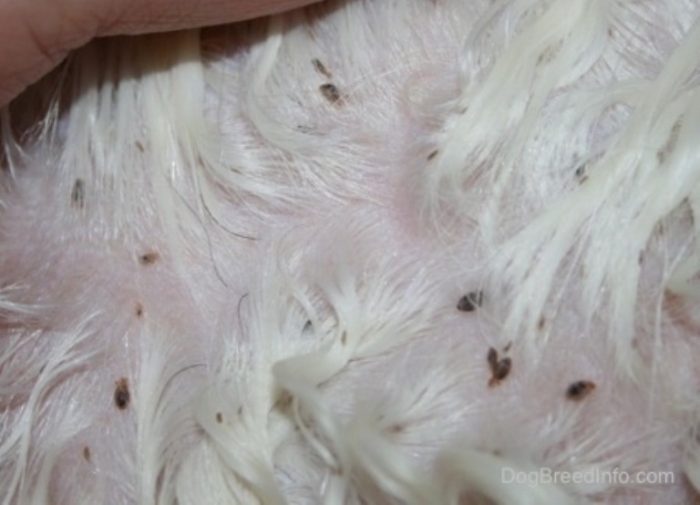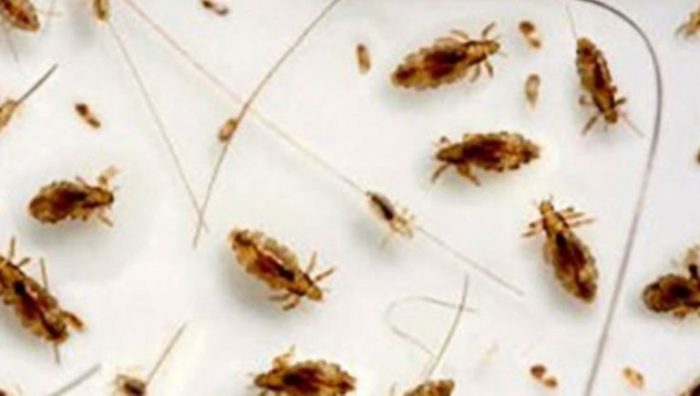Pet parents who have ever wondered if it is possible for their dogs to be infected with lice should know that the answer to that question is in the affirmative. Just like other pests, lice constitutes a nuisance and although the infestations are rare, when your dogs get lice, it may be because they came into contact with other infected pups, from grooming equipment that is not sanitized, or from infected beddings. While lice can attack dogs, there is a twist to the effect it has on their human parent. We explore the intricacies that come with dogs and lice.
Table of Contents
What Are Dog Lice?
Dog lice are tiny six-legged insects that thrive in the hair of mammals and the feathers of birds. The parasite is wingless with each leg equipped with strong hook-like claws; this is what they use to hang onto the hair shaft. These claws are usually adapted to the exact size of the host’s feathers or hair shaft; this is why the parasites are species-specific. Lice thrive on skin debris of their host, its sebaceous secretions, feathers, or the host’s blood.
When dogs get lice, they usually come in two types:
1. Chewing lice – This type of lice survives on surface secretion and skin debris. It has two types – Heterodoxus spiniger and Trichodectes canis that affect pups and wild canids. The former is not common in North America but is mostly found in the tropics. These lice are characterized by a flat blunt, head.
2. Sucking lice – Unlike the chewing type, the sucking lice survive on blood. Linognathus setosus is the name of the particular species of sucking lice found on dogs. They are characterized by their sharp and pointed mouthpiece.
Can Dogs Be Infested With Lice?
Yes, your pup can get infested with lice, both the chewing and sucking type but what are the ways dogs get lice? The most common way through which dogs get lice is exposure to infested pups, poor sanitation, and overcrowded households.
Grooming tools is another way through which lice can be transmitted in dogs. When you use combs and brushes that are contaminated with lice eggs on your dog, the cells will be passed on to the pup, thereby infecting it.
Groomers increase the spread of canine lice when they fail to disinfect their grooming tools. All those scissors, shavers, brushes, combs, and trimming equipment should be properly disinfected before using them on the next dog.
Dog parents who take their pooch to a groomer should ensure that the staff disinfects all grooming tools in-between grooming.
How To Know If Your Dog Has Lice
Lice become big when they are fully grown and thus, they can be visible to human eyes. The size is comparable to the size of a sesame seed and they come in tan or yellow color. They love to settle around a dog’s hair shafts, clinging to its coat and consuming dander, skin cells, and gland secretion. You can also find them around wounds and openings on the body. When dogs get lice, they usually display other symptoms like;
- Itchiness
- Redness
- Hair loss
- Greasy or flaky coat and skin
- Matter or clumped fur
Once these symptoms are observed, pet parents should check their pups for adult lice or the eggs also known as nits. These have the appearance of white specks sticking firmly to the infected dog’s hair shaft. The adult lice will equally stick to the hair, but they move around from time to time.
If dogs get lice, they become uncomfortable as the parasite feed or makes a movement. Besides, dogs that ingest the lice from chewing and licking their skin can get infected with tapeworm. Lice can also pave the way for bacterial infections on your dog’s skin and this complicates issues.
Multi-pet households should check other dogs in the house once any of their dogs get lice infections. This is because dogs that live together can transmit eggs or adult lice to one another by sharing living quarters and bedding.
Can You Get Lice From Your Dog?

The good news is that we shouldn’t panic when our dogs get lice since the infestation cannot be transmitted from dogs to humans. As we have already mentioned in the article, lice are known to be specie specific, thus, the one that survives on canine blood is not likely to change its dining preferences when it finds itself on the body of a human being.
What we are saying, in essence, is that human lice will stay on humans while canine lice will prefer their host to be a dog. Your kids are more likely to get lice infestation from their school or playground than from household pets.
Effective Ways To Get Rid Of Lice
Treating lice infection in dogs is fairly easy; take an infected pup to the vet who will recommend treatment. Important to note that ordinarily giving your pooch a bath is not likely to eliminate the lice. Lice cling to a dog’s hair shaft, holding so tight that mere soap and water are ineffective at eradicating them.
Topical Treatments
Your vet can recommend topical treatment for an infected dog; these come in the form of sprays, shampoos, and powders which have proved to be very effective in killing the lice. The active ingredients may include:
- Pyrethrin
- Lime-sulfur
- Pyrethroid
Treatment for fleas can also be effective in treating and preventing a lice infestation. Your vet may recommend
- Imidacloprid
- Fipronil
- Selamectin
Fur Shaving
Matted and clumped fur can occur when your dogs get lice and you can get rid of them by shaving. When a dog is shaved, the skin will be exposed; this ensures that the insecticide treatment gets in close contact with the lice, thereby killing them off.
Read Also: Dogs Foaming From The Mouth – 7 Causes And Quick Treatment
Treatment Duration
Due to the life cycle of lice, you may need to apply treatment multiple times with topical shampoos, sprays, or powders. Life expectancy for an adult female is approximately four weeks and they lay eggs on a daily basis. The nits take one or two weeks to hatch and mature into an egg-laying adult.
The adult lice will be killed with the initial treatment, but the eggs are not vulnerable to insecticides; thus, they will remain on the dog. Therefore, treatment should continue for at least four weeks to effectively eliminate all hatched nymphs. Treatment can be given every one to two weeks.
Treatment Risk Management
Pregnant dogs, certain breeds, and very young puppies can be at risk of insecticides, thus, when any of these dogs get lice, be sure to adhere to the instructions of the vet regarding treatment. Besides, the products for treatment should be kept out of the reach of kids and household pets and our hands should be protected with gloves when applying them.
Though it has been established that humans can’t get lice infestation from canines, we still have to remove and wash our clothes after applying the insecticide. Once each treatment session is completed, all the towels used for the treatment must be thoroughly washed.
